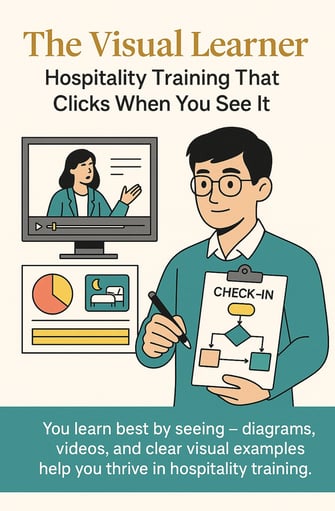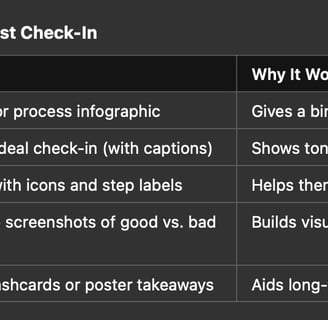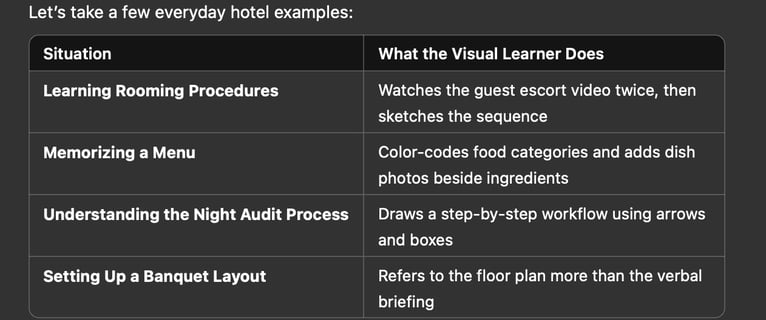🎨 The Visual Learner: Hospitality Training That Clicks When You See It
Discover how visual learners thrive in hospitality training environments. This article explores the traits, strengths, and learning preferences of visual learners, offering practical tips for both trainers and learners to create and absorb training content that truly sticks — through diagrams, SOP videos, infographics, and more. Perfect for hotel professionals looking to level up the way they teach and learn.
HOME PAGELEARNING
4/20/20253 min read


🏨 Hospitality in Action: Visual Learners on the Job
Let’s take a few everyday hotel examples:
This isn’t about preference. It’s about performance. When visual learners are given the right inputs, their recall, confidence, and accuracy go up dramatically.
⚖️ Strengths and Blind Spots
✅ Strengths:
Quick to absorb and replicate procedures when shown clearly
Good at spotting inconsistencies (they notice what looks off)
Often excel at branding, aesthetics, and layout-related tasks
⚠️ Blind Spots:
May feel lost in purely verbal briefings
Can get overwhelmed if visuals are cluttered or inconsistent
Might need longer to process abstract concepts unless visualized
As a trainer, if your SOP video is pixelated or your signage is inconsistent, this learner will silently disengage. And as a learner, if you’re not translating what you hear into what you can see, you’re leaving retention on the table.
🧭 Structuring a Topic for Visual Learners (Trainer’s View)
Let’s take the topic: Handling Guest Check-In
✅ Trainer Tip: Use consistent visual language — same icons, same color themes, and clear layouts. Don’t “design for design’s sake.” Design for clarity.
📘 How Visual Learners Should Approach a Course
(Learner’s View)
Visual learners — here’s how to take charge of your own learning:
Before the Session:
Skim any slides, visuals, or materials in advance
Create a mind map if the topic has multiple parts
During the Session:
Turn what you hear into what you see — sketch it out
Use highlighters or sticky notes to make things “pop” visually
After the Session:
Take screenshots or photos of whiteboards/charts (if permitted)
Make flashcards with images or color-coded cues
🎯 Learner Tip: Don’t be afraid to ask your trainer, “Could you show that with a diagram or photo?” You’re not being slow — you’re being smart.
🧩 The HTG Advantage
At HTG, we design training with learning types in mind.
That means:
Our SOPs come with diagrams, walkthroughs, and visual aides
Our trainers are trained to show before they tell
Our courses often include “visual-first” modes — from screen recordings to flashcard decks
If you’re a visual learner, we won’t ask you to adapt to the content. We’ll make the content adapt to you.
📨 Final Word
Learning is personal. It’s time our training felt personal too.
If you’re a Visual Learner, you’re not slower — you’re strategic. You process the world with your eyes, and when shown the right way, you don’t just learn — you remember, replicate, and elevate.
Want a free course built just for your style?
📩 Email us at hello@hospitalitytrainersguild.com
📎 Don’t forget to attach your resume.


In the hustle of hospitality, training often defaults to “just do it.” But not everyone learns best that way. Some of us need to see it first — clearly, cleanly, and with context.
Enter the Visual Learner.
This article is for you if you find yourself reaching for diagrams before diving into demos, or if you’ve ever said, “Can you show me what that looks like?” Whether you’re a hotelier trying to master a new SOP or a trainer designing a course for frontline teams — understanding visual learning can make training faster, smarter, and more sticky.
👀 Who Is the Visual Learner?
A visual learner absorbs information best when it’s seen — not just heard or done. They’re the ones who love:
Diagrams over descriptions
Infographics over long paragraphs
SOPs with photos and arrows
Videos with clean captions
Slide decks that are sharp, not crowded
They often think in images, connect ideas spatially, and rely heavily on visual memory to recall steps, details, or workflows.
You’ll spot a visual learner when they:
Take neat notes (often with doodles or color-coded highlights)
Ask “Can I see that again?”
Thrive with maps, org charts, and well-laid-out checklists
Struggle with audio-only explanations or verbal-only training

